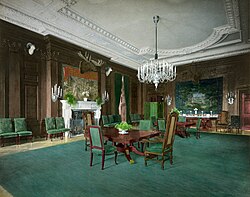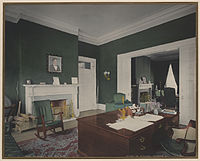
The Oval Office is the formal working space of the president of the United States. Part of the Executive Office of the President of the United States, it is in the West Wing of the White House, in Washington, D.C.

The Resolute desk, also known as the Hayes desk, is a nineteenth-century partners desk used by several presidents of the United States in the White House as the Oval Office desk, including the five most recent presidents. The desk was a gift from Queen Victoria to President Rutherford B. Hayes in 1880 and was built from the oak timbers of the British Arctic exploration ship HMS Resolute. The 1,300-pound (590-kilogram) desk was created by William Evenden, a skilled joiner at Chatham Dockyard in Kent, probably from a design by Morant, Boyd, & Blanford. The desk has been modified twice, with a kneehole panel added in 1945 and a 2-inch-tall (5.1 cm) plinth added to the desk in 1961.

Warder Mansion is an apartment complex at 2633 16th Street Northwest, in the Meridian Hill neighborhood of Washington, D.C. It is the only surviving building in the city designed by architect Henry Hobson Richardson. In an early example of preservation commitment, the building was saved from demolition in the 1920s by being disassembled and moved 1.5 miles (2.4 km) north of its original site. In the 1990s, the Warder-Totten House's prospects for survival again looked bleak, but the building was saved a second time.

The Blue Room is one of three state parlors on the first floor in the White House, the residence of the president of the United States. It is distinctive for its oval shape. The room is used for receptions and receiving lines and is occasionally set for small dinners. President Grover Cleveland married Frances Folsom in the room on June 2, 1886, the only wedding of a President and First Lady in the White House. The room is traditionally decorated in shades of blue. With the Yellow Oval Room above it and the Diplomatic Reception Room below it, the Blue Room is one of three oval rooms in James Hoban's original design for the White House.
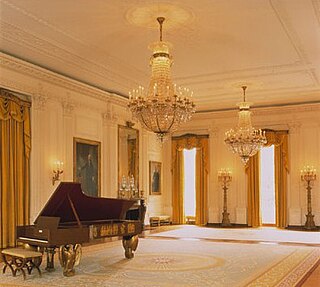
The East Room is an event and reception room in the Executive Residence of the White House complex, the home of the president of the United States. The East Room is the largest room in the Executive Residence; it is used for dances, receptions, press conferences, ceremonies, concerts, and banquets. The East Room was one of the last rooms to be finished and decorated, and it has undergone substantial redecoration over the past two centuries. Since 1964, the Committee for the Preservation of the White House has, by executive order, advised the president of the United States and first lady on the decor, preservation, and conservation of the East Room and other public rooms at the White House.
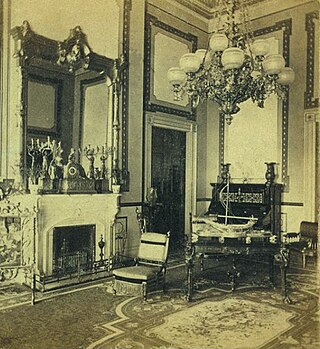
The Red Room is one of three state parlors on the State Floor in the White House, the Washington D.C. home of the president of the United States. The room has served as a parlor and music room, and recent presidents have held small dinner parties in it. It has been traditionally decorated in shades of red. The room is approximately 28 by 22.5 feet. It has six doors, which open into the Cross Hall, Blue Room, South Portico, and State Dining Room.

The Green Room is one of three state parlors on the first floor of the White House, the home of the president of the United States. It is used for small receptions and teas. During a state dinner, guests are served cocktails in the three state parlors before the president, first lady, and a visiting head of state descend the Grand Staircase for dinner. The room is traditionally decorated in shades of green. The room is approximately 28 by 22.5 feet. It has six doors, which open into the Cross Hall, East Room, South Portico, and Blue Room.

The State Dining Room is the larger of two dining rooms on the State Floor of the Executive Residence of the White House, the home of the president of the United States in Washington, D.C. It is used for receptions, luncheons, larger formal dinners, and state dinners for visiting heads of state on state visits. The room seats 140 and measures approximately 48 by 36 feet.

The Diplomatic Reception Room is one of three oval rooms in the Executive Residence of the White House, the official home of the president of the United States. It is located on the ground floor and is used as an entrance from the South Lawn and a reception room for foreign ambassadors to present their credentials, a ceremony formerly conducted in the Blue Room. The room is the point of entry to the White House for a visiting head of state following the State Arrival Ceremony on the South Lawn. The room has four doors, which lead to the Map Room, the Center Hall, the China Room, and a vestibule that leads to the South Lawn.

The Yellow Oval Room is an oval room located on the south side of the second floor in the White House, the official residence of the president of the United States. First used as a drawing room in the John Adams administration, it has been used as a library, office, and family parlor. It was designated the Yellow Oval Room during the restoration overseen by First Lady Jacqueline Kennedy. Today the Yellow Oval Room is used for small receptions and for greeting heads of state immediately before a State Dinner.

The Family Dining Room is a dining room located on the State Floor of the White House, the official residence of the president of the United States. The room is used for smaller, more private meals than those served in the State Dining Room. Used in the 1800s as a space for the First Family to have their meals, the Family Dining Room was used less for family meals and more for working lunches and small dinners in the 20th and 21st centuries.

Daniel Pabst was a German-born American cabinetmaker of the Victorian Era. He is credited with some of the most extraordinary custom interiors and hand-crafted furniture in the United States. Sometimes working in collaboration with architect Frank Furness (1839–1912), he made pieces in the Renaissance Revival, Neo-Grec, Modern Gothic, and Colonial Revival styles. Examples of his work are in the collections of the Metropolitan Museum of Art, the Philadelphia Museum of Art, the Art Institute of Chicago, and the Victoria and Albert Museum in London.

Warder Public Library is a historically significant building in Springfield, Ohio, United States. A robust example of Richardsonian Romanesque architecture, it was a gift to the city from industrialist Benjamin H. Warder, and served as the main branch of the Clark County Public Library from 1890 to 1989. It now houses the Clark County (Warder) Literacy Center.
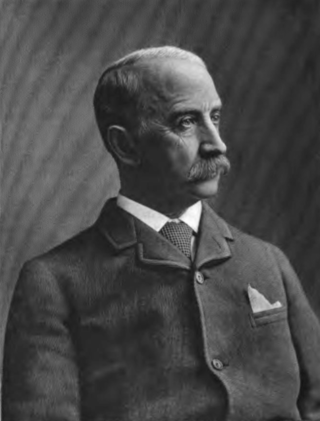
Benjamin Head Warder was an American manufacturer of agricultural machinery, based in Springfield, Ohio, for much of his career. After he had retired, in 1902 the company he co-founded merged with four others to form International Harvester. Warder commissioned and donated a new library for Springfield in 1890, as a memorial to his parents.

Kimbel & Cabus was a Victorian-era furniture and decorative arts firm based in New York City. The partnership was formed in 1862 between German-born cabinetmaker Anthony Kimbel and French-born cabinetmaker Joseph Cabus (1824–1894). The company was noted for its Modern Gothic and Anglo-Japanese style furniture, which it popularized at the 1876 Centennial Exposition.

The desk in the Vice President's Ceremonial Office in the Eisenhower Executive Office Building, colloquially known as the Theodore Roosevelt desk, is a large mahogany pedestal desk in the collection of the White House. It is the first of six desks that have been used by U.S. presidents in the Oval Office, and since 1961 has been used as the desk of the U.S. Vice President.

The Hoover desk, also known colloquially as FDR's Oval Office desk, is a large block front desk, used by Presidents Herbert Hoover and Franklin D. Roosevelt in the Oval Office. Created in 1930 as a part of a 17-piece office suite by furniture makers from Grand Rapids, Michigan, the Art Deco desk was given to the White House by the Grand Rapids Furniture Manufacturers Association during the Hoover administration. The desk was designed by J. Stuart Clingman, and was built by the Robert W. Irwin Company from American lumber and faced with Michigan-grown maple burl wood veneer. After Roosevelt's sudden death in 1945, Harry S. Truman removed the desk from the Oval Office and gave it to Roosevelt's wife, Eleanor Roosevelt. She displayed it at, and later donated it to, the Franklin D. Roosevelt Presidential Library and Museum in Hyde Park, New York. The desk has been on display there ever since. The Hoover desk is one of only six desks to be used by a president in the Oval Office.

The Johnson desk is a mahogany partners desk that was used by U.S. President Lyndon B. Johnson in the Oval Office as his Oval Office desk. One of only six desks used by a president in the Oval Office, it was designed by Thomas D. Wadelton and built in 1909 by S. Karpen and Bros. in Chicago. The desk was built as part of 125 seven-piece office sets for senators' offices in the Russell Senate Office Building, and was used by Johnson during his terms as U.S. Senator, Vice President, and President. It is currently located at the Lyndon Baines Johnson Library and Museum as part of a replica Oval Office.
